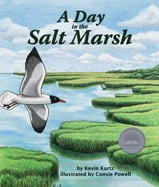Alignment to Standards for ME

| Grade | Number | Standard |
|---|---|---|
| 5-Mar | SC-3-5-C3)b | Give examples of changes in the environment caused by natural or man-made influences. |
| 5-Mar | SC-3-5-E1) | Students compare living things based on their behaviors, external features, and environmental needs. |
| 5-Mar | SC-3-5-E1)a | Describe how living things can be sorted in many ways, depending on which features or behaviors are used to sort them, and apply this understanding to sort living things. |
| 5-Mar | SC-3-5-E2) | ways organisms depend upon, interact within, and change the living and non-living environment as well as ways the environment affects organisms. |
| 5-Mar | SC-3-5-E2)c | Describe some of the ways in which organisms depend on one another, including animals carrying pollen and dispersing seeds. |
| 5-Mar | SC-3-5-E2)e | Explain how organisms can affect the environment in different ways. |
| 5-Mar | SC-3-5-E4)a | Name some likenesses between children and parents that are inherited, and some that are not. |
| 5-Mar | SC-3-5.A1) | Students explain interactions between parts that make up whole man-made and natural things. |
| 5-Mar | SC-3-5.A1)a | Give examples that show how individual parts of organisms, ecosystems, or man-made structures can influence one another. |
| 5-Mar | SC-3-5.A3) | Students identify and represent basic patterns of change in the physical setting, the living environment, and the technological world. (seasons, moon phases, life cycles) |
| 5-Mar | SC-3-5.A3)a | Recognize patterns of change including steady, repetitive, irregular, or apparently unpredictable change. |
| 5-Mar | SS.D1.3-5)a | Geography includes the study of Earthês physical features including climate and the distribution of plant, animal, and human life. |
| 5-Mar | SS.D1.3-5)c | Identify the Earthês major geographic features such as continents, oceans, major mountains, and rivers using a variety of geographic tools. |
| 5-Mar | SS.D1.3-5)d | Explain examples of changes in the Earthês physical features and their impact on communities and regions. |
| PK-2 | SC-PK-2-E1) | similarities and differences in the observable behaviors, features, and needs of plants and animals. |
| PK-2 | SC-PK-2-E1)a | similarities and differences in the way plants and animals look and the things that they do. |
| PK-2 | SC-PK-2-E1)b | Describe some features of plants and animals that help them live in different environments. |
| PK-2 | SC-PK-2-E2) | Students understand how plants and animals depend on each other and the environment in which they live. |
| PK-2 | SC-PK-2-E2)a | Explain that animals use plants and other animals for food, shelter, and nesting. |
| PK-2 | SC-PK-2-E2)b | Compare different animals and plants that live in different environments of the world. |
| PK-2 | SC-PK-2-E3) | parts and wholes of living things, their basic needs, and the structures and processes that help them stay alive. |
| PK-2 | SC-PK-2-E3)c | Identify structures that help organisms do things to stay alive. |
| PK-2 | SC-PK-2-E5)a | Describe some organismsê features that allow the organisms to live in places others cannot. |
| PK-2 | SC-PK-2.A3) | the physical setting, the living environment, and the technological world some things change over time and some things stay the same. |
| PK-2 | SC-PK-2.A3)a | size, weight, color, or movement of things over varying lengths of time and note qualities that change or remain the same. |